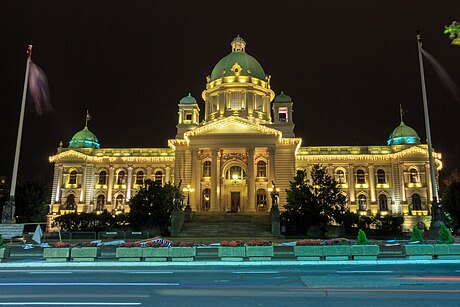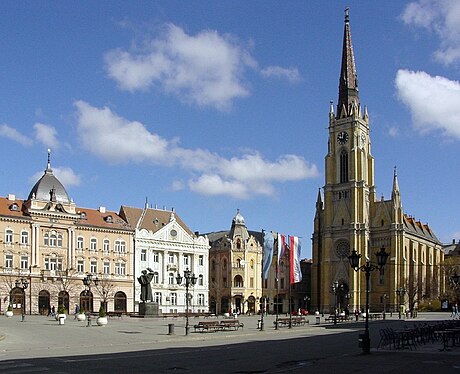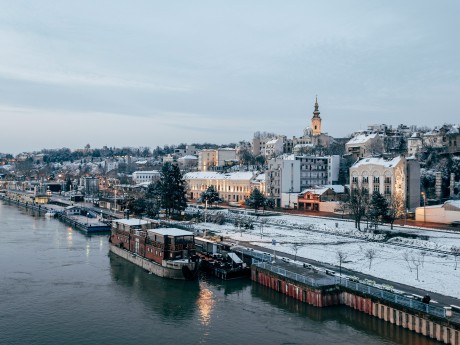Serbia: Belgrade & Novi Sad
Embark on a journey to Serbia, an immersive experience steeped in history, culture, and scenic wonders. In Belgrade, the dynamic capital city, wander through the historic streets of the Old Town, where you'll encounter architectural marvels like the Cathedral of Saint Sava. Revel in the lively atmosphere of Skadarlija, Belgrade's bohemian quarter, renowned for its cobblestone streets and traditional Serbian restaurants.
Read more
Embark on a journey to Serbia, an immersive experience steeped in history, culture, and scenic wonders. In Belgrade, the dynamic capital city, wander through the historic streets of the Old Town, where you'll encounter architectural marvels like the Cathedral of Saint Sava. Revel in the lively atmosphere of Skadarlija, Belgrade's bohemian quarter, renowned for its cobblestone streets and traditional Serbian restaurants. In Novi Sad, Serbia's cultural gem, explore the iconic Petrovaradin Fortress, affectionately known as the "Gibraltar of the Danube," offering breathtaking views of the city. For a relaxing escape, venture to Danube Park, where you can unwind amidst lush greenery, tranquil lakes, and scenic vistas. Alternatively, experience the lively ambiance of Dunavska Street, brimming with bustling cafes, trendy boutiques, and vibrant street art, providing a glimpse into Novi Sad's thriving cultural scene. A trip to Serbia promises to be an unforgettable journey filled with history, culture, and adventure at every turn. Waterviews strives to offer accommodation options within walking distance of water and/or in an area of touristic interest. Our prices include taxes (but excludes local tourist taxes). Customize your trip to your personal preferences with optional activities (hit the “Add Activities’’) or change hotels, etc. Contact us for customization at no extra cost at: Service@waterviewstravel.com
Destinations
- Belgrade
- Novi Sad
Itinerary
Belgrade

Belgrade (Serbian: Београд, Beograd) — meaning 'White City' — is the capital of the Republic of Serbia. With a population of over 1.7 million people, Belgrade has been re-emerging as a tourist destination in the past years. Often called the party capital of Southeastern Europe, Belgrade is famous for offering numerous entertainment venues, many historical sites, great local food, and warm people. Various styles of architecture are found in the city, and its recent resurgence as the leading hub in Southeastern Europe makes it a must-see destination.
Read more
Belgrade (Serbian: Београд, Beograd) — meaning 'White City' — is the capital of the Republic of Serbia. With a population of over 1.7 million people, Belgrade has been re-emerging as a tourist destination in the past years. Often called the party capital of Southeastern Europe, Belgrade is famous for offering numerous entertainment venues, many historical sites, great local food, and warm people. Various styles of architecture are found in the city, and its recent resurgence as the leading hub in Southeastern Europe makes it a must-see destination.
Additional Information
History
Belgrade is the country's largest city. It lies on the confluence of the Sava and Danube rivers. The city has a long history, dating back to the 4th century BC, when the area was settled by Celtic tribes. Later, it became the Roman city of Singidunum, and relics of that era can still be seen in the city, particularly at the Belgrade Fortress. During the Middle Ages the town became a Serbian stronghold until the Ottoman invasion. The city changed hands between the Ottoman and the Austrian empires several times until 1878, when Serbia gained its independence and Belgrade became the capital of the new country.
After the First World War, Belgrade became the seat of the Kingdom of Serbs, Croats and Slovenes (in 1929, the country changed its name to Kingdom of Yugoslavia) until its collapse in 1943. Due to its strategic location, the city has endured more than 115 wars and has been destroyed more than 40 times. This often violent history and outside influence has colored much of Belgrade's evolution, which is evident in its culture and architecture. Often caught between the hammer and anvil of clashing empires, the city has taken on a unique character, reminiscent of both Austrian and Turkish influences, with a unique set of Communist elements thrown in as Yugoslavia was expelled from the Eastern Bloc in 1948 but followed its own brand of communism until Marshal Tito died in 1980. The city has its own spirit, and in it can be found some not only unique features, but also a healthy joie de vivre in its café culture, nightlife and often a Mediterranean touch in its daily life.
Climate
Belgrade has a temperate continental climate, with hot, humid summers and cold winters with occasional periods of snowfall. Belgrade experiences all four seasons to their maximums, and those visiting are advised to dress appropriately, and keep an eye on the weather forecast, as the city often experiences sudden gusts of the strong Košava wind, storms, and rainfall, particularly during the summer months.
People
Whilst there isn't much ethnic or cultural diversity in Belgrade compared to other European cities, there are minority communities (largely Roma and Chinese), as well as people from other former Yugoslav republics, such as Bosnia, Croatia and Macedonia. There is also a small expat community. Cultural events from around the world, however, are starting to become increasingly common, particularly in the spring and summer months, sponsored by local arts and culture organizations, and by foreign embassies and cultural centers. These attract a good deal of local attention, and help in raising the city's profile as a cultural hotspot.
Belgradians, like most Serbs, are friendly and hospitable people, who will always go out of their way to make guests feel welcome. Whatever the ethnicity, any tourist who comes to Belgrade and treats the locals kindly will see that kindness returned doubled. Most young people speak English well, and usually another foreign language such as German, Russian, or French. As with any destination, it could prove useful to learn some of the local phrases.
© Sourced from Wikivoyage
Novi Sad

Novi Sad (Serbian: Нови Сад/Novi Sad) is the capital of Vojvodina, the northern Autonomous Province of Serbia, and the second largest city in Serbia. Situated on the Danube River between Budapest and Belgrade, it is a treasured regional and cultural centre. Novi Sad has a population of around 300,000 people.
Read more
Novi Sad (Serbian: Нови Сад/Novi Sad) is the capital of Vojvodina, the northern Autonomous Province of Serbia, and the second largest city in Serbia. Situated on the Danube River between Budapest and Belgrade, it is a treasured regional and cultural centre. Novi Sad has a population of around 300,000 people.
Additional Information
Novi Sad is the second largest city in Serbia. It is architecturally (and, to an extent, culturally) different from other larger cities in central and south Serbia such as Belgrade and Niš, since it was not under the Ottoman influence but instead, that of the Austro-Hungarian Empire. The buildings in the city centre resemble the ones in Vienna and Budapest.
Novi Sad is a university town, with more than 40,000 students attending the University of Novi Sad, which is on a beautiful green campus near the Danube. Because of the abundance of young people, Novi Sad has many bars, "hipstery" places, and is generally more open-minded than the rest of Serbia.
The people of Novi Sad are known to be relaxed and easy going, sometimes a bit too slow-paced for the other Serbians from the central and south of Serbia (their accent is one example of this).
Novi Sad is very flat (which makes it suitable for biking), with wide streets and lots of trees. For those who love hiking, there is a mountain, Fruška Gora, less than 15 km away, which is a national park featuring beautiful nature and many old monasteries.
Tourists that come to Novi Sad are usually impressed the most by Serbian cuisine, very low prices by Western standards, and by the hospitality of Serbian people. Many tourists come to Novi Sad for Exit Festival which takes place on the Petrovaradin fortress in early July.
History
The area of Novi Sad was inhabited since the distant past - the found remains of old settlements date back to the Neolithic period (5000 BCE). Before the middle ages, the region was inhabited by different tribes, including Celts, Romans, and Huns. Slavic tribes (including Serbs) settled the region around Novi Sad mainly in the 6th and 7th century. The region was under the medieval Kingdom of Hungary in the 11th and 12th century and afterwards under the Ottomans from 1526 until 1687, when Habsburg Monarchy took over the control.
The settlement was declared a "free royal city” by the Habsburg empress Maria Theresa in 1748, and it gained its present names Novi Sad, Újvidék, and Neoplanta, meaning “new plantation” in Serbian, Hungarian, and Latin, respectively. For much of the 18th and 19th centuries, this was the largest Serb-inhabited city in the world, part of the Austro-Hungarian Empire until the end of World War I in 1918, when it became part of Kingdom of Serbia. During World War II, it was under Hungarian occupation.
After the World War II, the city went through rapid industrialization and its population more than doubled in the period between World War II and the breakup of Yugoslavia after the fall of the Soviet Union. Devastated by NATO bombardment that lasted 78 days during the Kosovo War of 1999, Novi Sad was left without any of its three Danube bridges, and with significant damage to its infrastructure including communications, water, and electricity. Residential areas were cluster-bombed several times while its oil refinery was bombarded daily.
Novi Sad has mostly recovered from the 1990s and it has grown strongly since 2001, shifting its economy from industry-driven to the tertiary sector. It is home of the national headquarters of numerous banks, third largest insurance company in Serbia, and major energy companies. Novi Sad is also a growing information technology center in Serbia.
Climate
Novi Sad has a continental climate, with four distinct seasons. The best weather is generally between April and September.
Winters are cold, with temperatures being below zero for a couple of weeks per year, often accompanied with snow (which stays for a couple of days or more at a time). The first snow usually falls in late November/early December.
Springs are short and rainy. On the first warm and sunny day after the winter, usually in March, the people of Novi Sad come out to the city centre to have a drink in a cafe in Zmaj Jovina street, or take a walk on the promenade next to the Danube.
Summers often arrive abruptly, with temperatures above 25°C being very common, starting as early as May. If the weather becomes too hot, you can have a swim at Štrand, a well-maintained public beach on the river Danube, popular with the locals. If you want to have a proper swim, the outdoor pool at Spens is an option. Go early in the morning to avoid the crowds. Short heavy rains occur from time to time in the summer, cooling the air for a couple of hours. The weather remains warm until the middle of September or later.
Autumns arrive usually by the beginning of October, and are not too cold, with the temperatures between 10 and 20°C. Rain is not uncommon in this period, however there are many sunny days too. The leaves changing colours and falling from the trees make Novi Sad quite beautiful, especially in the parks and on the promenade next to the Danube.
© Sourced from Wikivoyage





